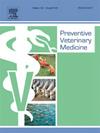Diseases associated with antimicrobial use in pig farms and risk factors thereof: A cross-sectional study in the Netherlands
IF 2.4
2区 农林科学
Q1 VETERINARY SCIENCES
引用次数: 0
Abstract
Background
Current antimicrobial use (AMU) in Dutch pig farms is driven by herd health status, as only therapeutic AMU is permitted. This study focused on weaners and sows with suckling piglets to examine the diseases associated with i) overall AMU (measured in Defined Daily Dosage Animal per year – DDDA/Y), ii) use/not use of specific antimicrobial classes, iii) total consumption of specific antimicrobial classes (in DDDA/Y), and iv) farm characteristics linked to the occurrence of diseases that require AMU.
Methods
Cross-sectional data on AMU, disease aetiologies for group treatments, and farm characteristics were collected from 154 Dutch pig farms, representing the situation in 2019. Associations between disease occurrence as a predictor and AMU (overall and by antimicrobial class) as an outcome were analyzed using multivariable generalized linear regression models. Subsequently, mixed-effects conditional Random Forest analysis was used to identify farm characteristics associated with these diseases.
Results
Group treatments for musculoskeletal/neurological diseases (MNDs) in suckling piglets, and individual treatments (of unknown aetiology) in sows and suckling piglets, were significantly associated with total AMU there. AMU in weaners was significantly associated with respiratory diseases, MNDs, and individual treatments. Tetracyclines and penicillins were primarily used for respiratory diseases and MNDs in weaners, respectively, and for MNDs in sows and suckling piglets. Having a clear separation between clean and dirty outdoor areas in the farm and using boars from own production for estrus detection were both protective against occurrence of respiratory conditions in weaners, whereas PRRS vaccination in suckling piglets was a risk factor. Streptococcus suis vaccination in sows and fully slatted floors were both risk factors for MNDs in weaners, whereas being an organic farm was protective. Use of disinfecting powders in sows increased MNDs risk in suckling piglets and sows, and a longer lactation period was protective against respiratory diseases and MNDs in weaners.
Conclusions
Respiratory diseases and MNDs in weaners appeared as the primary aetiologies for antimicrobial group treatments on Dutch pig farms. Prioritizing farm practices that enhance biosecurity and animal welfare is crucial for controlling these diseases and, consequently, reducing AMU.
猪场中与抗菌剂使用相关的疾病及其危险因素:荷兰的一项横断面研究
背景荷兰养猪场目前的抗菌药使用(AMU)受猪群健康状况的影响,因为只允许使用治疗性抗菌药。本研究以断奶仔猪和哺乳仔猪母猪为研究对象,探讨与以下因素相关的疾病:i) AMU总量(以每年动物定义日剂量(DDDA/Y)计算);ii) 使用/不使用特定抗菌药类别;iii) 特定抗菌药类别的总消耗量(以DDDA/Y计算);iv) 与需要AMU的疾病发生相关的猪场特征。方法从 154 个荷兰猪场收集了有关 AMU、集体治疗的疾病病因和猪场特征的横断面数据,这些数据代表了 2019 年的情况。使用多变量广义线性回归模型分析了作为预测因子的疾病发生率与作为结果的AMU(总体和抗菌药类别)之间的关联。结果哺乳仔猪肌肉骨骼/神经系统疾病(MNDs)的集体治疗以及母猪和哺乳仔猪的个体治疗(病因不明)与 AMU 总量显著相关。断奶仔猪的 AMU 与呼吸道疾病、多发性神经病和个别治疗显著相关。四环素类和青霉素类药物分别主要用于断奶仔猪的呼吸道疾病和多发性硬化症,以及母猪和哺乳仔猪的多发性硬化症。猪场室外清洁区和脏乱区的明显分隔以及使用自产公猪进行发情检测均可预防断奶仔猪呼吸道疾病的发生,而乳仔猪接种 PRRS 疫苗则是一个风险因素。母猪接种猪链球菌疫苗和铺设全板条地板都是断奶仔猪发生 MND 的风险因素,而有机农场则具有保护作用。母猪使用消毒粉增加了哺乳仔猪和母猪患多发性猪营养不良症的风险,而较长的哺乳期对断奶仔猪的呼吸道疾病和多发性猪营养不良症具有保护作用。优先考虑提高生物安全和动物福利的猪场实践对于控制这些疾病,进而减少 AMU 至关重要。
本文章由计算机程序翻译,如有差异,请以英文原文为准。
求助全文
约1分钟内获得全文
求助全文
来源期刊

Preventive veterinary medicine
农林科学-兽医学
CiteScore
5.60
自引率
7.70%
发文量
184
审稿时长
3 months
期刊介绍:
Preventive Veterinary Medicine is one of the leading international resources for scientific reports on animal health programs and preventive veterinary medicine. The journal follows the guidelines for standardizing and strengthening the reporting of biomedical research which are available from the CONSORT, MOOSE, PRISMA, REFLECT, STARD, and STROBE statements. The journal focuses on:
Epidemiology of health events relevant to domestic and wild animals;
Economic impacts of epidemic and endemic animal and zoonotic diseases;
Latest methods and approaches in veterinary epidemiology;
Disease and infection control or eradication measures;
The "One Health" concept and the relationships between veterinary medicine, human health, animal-production systems, and the environment;
Development of new techniques in surveillance systems and diagnosis;
Evaluation and control of diseases in animal populations.
 求助内容:
求助内容: 应助结果提醒方式:
应助结果提醒方式:


